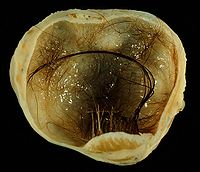
Photo from wikipedia
To the editor: We read with great interest the article by Wang et al. (1) which identified the value of carbohydrate antigen 19-9 (CA19-9) and [lymphocyte × albumin (ALB), LA]… Click to show full abstract
To the editor: We read with great interest the article by Wang et al. (1) which identified the value of carbohydrate antigen 19-9 (CA19-9) and [lymphocyte × albumin (ALB), LA] in differentiating serous cystic neoplasms (SCNs) and mucinous cystic neoplasms (MCNs). We appreciated the great efforts that the authors made to help the management of pancreatic cystic neoplasms (PCNs). However, some concerns arise which may limit the strength of the evidence level of this study. First, it is widely acknowledged that a high level of CA19-9 is associated with advanced PCNs. The value of inflammatory markers based on circulating blood cells in predicting advanced PCNs is not well studied. The hypothesis that CA19-9 and inflammatory markers may be useful in differentiating MCN and SCN raised by the authors is mostly based on studies that focus on pancreatic cancer and other malignant tumors. However, MCNs are premalignant tumors, only 10%–17% of which will harbor malignancy (2). The hypothesis may not be applicable to PCN due to lack of reference support. Moreover, the cyst fluid CA19-9 has little value in distinguishing mucinous and non-mucinous PCNs and even the value of cyst fluid carcinoma embryonic antigen (CEA) was doubted at present (2). The conclusions are opposite to the statement in the introduction section raised by authors. Second, eight MCNs were reported to have a malignant transformation in the study cohort. It means that the MCN patients had a more malignant rate than SCNs (18.8% vs 0%, P = 0.008). Hence, the results of the study merely indicate that CA19-9 and LA may be useful in differentiating benign and malignant tumors. The eight cases with malignancy should be excluded to further identify whether these indicators are still useful in differentiating MCNs and SCNs.
Journal Title: Frontiers in Oncology
Year Published: 2022
Link to full text (if available)
Share on Social Media: Sign Up to like & get
recommendations!